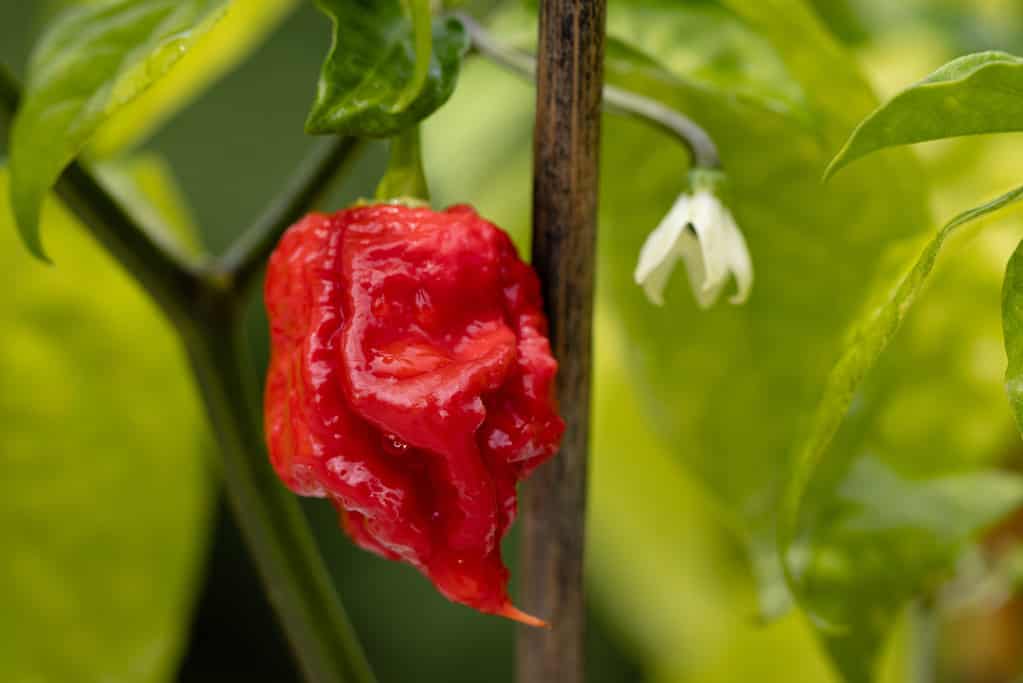The Carolina Reaper is a chili pepper that was created by “Smokin’” Ed Currie, a chili pepper breeder who founded the PuckerButt Pepper Company in 2003. Today, the company is the largest organic pepper farm in the United States. Currie worked for over ten years to develop the Carolina Reaper. After hundreds of different hybridization experiments, he crossed a La Soufriere pepper from Saint Vincent and the Grenadines with a Naga pepper from Pakistan. The result would officially be named “Smokin’ Ed’s Carolina Reaper.” It would also claim a spot in the Guinness Book of World Records as the hottest chili pepper in history, a record it would hold for ten years.

The Carolina Reaper was the hottest pepper for a decade.
©Adrian_am13/Shutterstock.com
How Hot Is a Carolina Reaper Pepper?
The average Carolina Reaper chili pepper registers 1.64 million Scoville Heat Units (SHU). The hottest individual Carolina Reaper ever documented registered a sweltering 2.2 million SHU.
The Carolina Reaper claimed the record as the world’s hottest pepper in 2013. It topped the Trinidad Moruga Scorpion pepper, which averages around 1.2 million SHU. Individual Trinidad Moruga Scorpions can register over two million SHU.
If you’ve never tried a Carolina Reaper, then these numbers on your phone or computer screen may not mean that much to you. How do these Scoville numbers affect real people who eat a real, authentic Carolina Reaper?
Eating a Carolina Reaper
For starters, there is the story of an NPR reporter who was documenting the story of the Carolina Reaper. According to Currie, the reporter ate a small piece of the pepper and soon after was rolling around on the floor and hallucinating.
In another instance, a man reportedly arrived at an emergency room in New York after eating a Carolina Reaper. As the story goes, he was suffering from a thunderclap headache, which is a sudden headache that is severe and extremely dangerous. A thunderclap headache can signal blood vessel issues or even bleeding in the brain.

Have you ever seen a fire eater? Biting into a Carolina Reaper is kind of like that!
©Dan Zen from Dundas, Canada / CC BY 2.0 – License
The PuckerButt website describes it thusly: “If you are ‘stupit’ enough to eat this pepper whole, you may wish to enter the doors of death willingly! Be very, very careful using this pepper. Those who don’t fear the Reaper are fools. Its Scoville rating is 1,641,300 SHU. The flavor is sweet and fruity, with a hint of cinnamon andand chocolate undertones. Uses include hot sauces, salsas, cooking, settling old scores, and combat.”
The Carolina Reaper on Good Mythical Morning
As it turns out, two world-famous YouTubers were “stupit” enough to eat a whole Carolina Reaper. Rhett McLaughlin and Lincoln “Link” Neal are the hosts of the wildly popular YouTube series Good Mythical Morning. In Season 6, Episode 56 of the show (which debuted on September 29, 2014), the duo took on the Carolina Reaper pepper. As you can see in the video below, the searing heat from the pepper sent the two internet stars into nauseated fits of pain, anger, regret, and utter despair.
The Scoville Scale
American pharmacist Wilbur Scoville developed the Scoville scale, that is a test to measure a pepper’s pungency (level of spiciness or heat).

Wilbur Scoville created a scale to measure a pepper’s spiciness in 1912.
©College Yearbook / Public domain – License
The test is based on the concentration of capsaicin and other capsaicinoids in a pepper or other food product. These chemicals are neurotoxins that are released as a fine spray when you bite into a pepper. They produce a burning sensation that triggers a chain reaction throughout your body. As this video from Pfizer explains, you don’t taste spicy food. You feel it.
An Interesting Capsaicin Theory
Capsaicin is present throughout a pepper, but it is most concentrated in and around the seeds. This led to the theory that high capsaicin levels developed as a mechanism to aid the proliferation of these plants.
When mammals eat the fruit of these plants, their teeth grind and destroy the seeds. However, high capsaicin levels cause pain when they contact mammalian tissue, so mammals often shy away from the plants. Birds, however, are unaffected by capsaicin. And, since birds also do not chew, the seeds stay intact when a bird feeds on the fruit of these plants. Instead, the seeds are dispersed when the bird defecates, promoting new plant growth.
Other Pepper Scoville Ratings
Here’s a look at how some of the world’s most popular peppers rank on the Scoville scale.
- Bell peppers are the ultimate mild peppers. They have zero SHU.
- Pimientos have only the slightest hint of spiciness, registering just 500-1,000 SHU.
- Poblanos are also relatively mild peppers, with 1,000-2,000 SHU.
- The jalapeño is considered by many to be a spicy pepper. These famous red or green peppers can carry an SHU rating anywhere from 2,500 to 10,000.
- Tabasco and cayenne peppers are significantly hotter than jalapeños. Both of these peppers register 30,000-50,000 SHU.
- Habanero peppers are very hot, with 100,000-350,000 SHU.
- Ghost peppers carry an intense blast of heat, registering over one million SHU. The SHU content is so high that these peppers are smeared on fences or incorporated into smoke bombs to deter wild elephants in India.
The Carolina Reaper tops all of these peppers with its 1.64 million SHU. It even has a higher SHU rating than many pepper sprays carried by police, which often register around 1.6 million SHU.
The Carolina Reaper’s Name
The Carolina Reaper is a bright red pepper with a rough outer surface. While the pepper was in development, it was known as HP22B (which stood for Higher Power, Pot No. 22, Plant B).

The “Reaper” is named for its scythe-like tail.
©iStock.com/Wirestock
The final product was named the Carolina Reaper, first of all, because Currie developed it in Fort Mill, South Carolina, where his company is located. The “Reaper” is a reference to the shape of the pepper’s tail, which has been likened to the mythological scythe of the Grim Reaper.
Carolina Reaper Eating Records
While the Carolina Reaper has left countless victims writhing in its wake, one competitive eater was undeterred by its fearsome reputation. Mike Jack is a vegan speed eater from Ontario, Canada, who took on the challenge to become the fastest person ever to consume 50 Carolina Reapers. Jack ate 50 of the insanely hot peppers in just 6 minutes and 49.2 seconds, a world record!
Not satisfied with the speed record, Jack went on to eat 85 more Carolina Reapers. Shockingly, Jack’s consumption of 135 peppers is not the most Carolina Reapers ever eaten in one sitting. That gastronomic record belongs to Gregory ‘Iron Guts’ Barlow, who ate an astonishing 160 Carolina Reapers in 2022!
Pepper X

Pepper X set a new record for the world’s hottest pepper in 2023.
©Jack / CC BY-SA 4.0 – License
The Carolina Reaper held the record for the world’s hottest pepper from 2013 until 2023. “Smokin’” Ed Currie, who is never satisfied with his absurdly spicy peppers, broke his own world record with the release of Pepper X.
Like the Carolina Reaper, Currie spent the better part of a decade perfecting the new pepper. Pepper X is a hybrid of the Carolina Reaper and an unnamed mystery pepper that Currie described as “brutally hot.” As you can see in the video below, Currie is completely dedicated to his craft and to his team, choking back tears when he received the new Guinness world record.
Pepper X registers 2.693 million SHU. That is even higher than a bear spray, which typically has 2.2 million SHU.
Is this the end of Currie’s pursuit of hot pepper perfection? Not likely. In an interview with ABC, Currie wryly smiled and said, “No, this is not the pinnacle.”
We’re breaking into a sweat just imagining what he has planned next!
The photo featured at the top of this post is © iStock.com/Wirestock
Thank you for reading! Have some feedback for us? Contact the AZ Animals editorial team.







